Roofwater Harvesting In California: Obstacles and Opportunities
The WATER Institute released this roofwater report in June 2011 that supports statewide adoption of this valuable water conservation strategy to increase community water security and stream flows for salmonid recovery. This report was a result of a meeting in 2010 and offers a broad overview of the status of roofwater harvesting in California, investigates obstacles, proposes solutions, offers recommendations for next steps and provides resources for further research.
Table of Contents
Executive Summary
Background
Cultural Analysis
Regulatory Analysis
Technical Analysis
Scientific Analysis
Economic Analysis
Recommendations
Appendix 1
Appendix 2
Acknowledgements
Brock Dolman and Kate Lundquist of the Occidental Arts and Ecology Center’s WATER Institute produced this document, together with Kevin Swift of Swift Writing. Kyla D. Schwaberow provided layout and design. Wesley Look created the list of California agencies that exert power over water. All photos by Brock Dolman, unless otherwise noted.
Much of the information in this document originated at a meeting held in November 2010 at the Occidental Arts and Ecology Center (OAEC). Thanks to Dave Henson, Executive Director of OAEC, for facilitating this day long meeting and to the staff of OAEC for hosting and providing a delicious organic lunch. We would like to thank the following participants who contributed their valuable time and input at this meeting:
Brian Cluer — National Oceanic and Atmospheric Administration Fred Euphrat — Forest, Soil & Water, Inc.
Eric Berntsen — CA StateWater Board
Steven Chatham — Prunuske Chatham, Inc.
Lauren Hammack — Prunuske Chatham, Inc.
Mary Ann King — Trout Unlimited
Brad Daniels — Trout Unlimited
Carrie Sendak — Salmon Protection and Watershed Network Jeff Adams — Salmon Protection and Watershed Network
Thanks to the Gold Ridge RCD and Matthew Deitch of the Center for Ecosystem Management and Restoration, for use of his GreenValley Creek Hydrograph (GreenValley CreekWatershedAssessment,Gold Ridge RCD 2010), and the City of Santa Rosa Utilities Department for the use of their ETo graph.
Thanks also to the following organizations and web sites from which many of our resources were derived: www. harvesth2o.com, www.salmoncreekwater.org, www.harvestingrainwater.com, www.spawnusa.org
Cover photo: Residential roofwater system installed by the Gold Ridge RCD’s Save Our Salmon (SOS) program in Bodega, CA www.goldridgercd.org/project/SOS.html
This report was made possible with support from the National Oceanic and Atmospheric Administration.
EXECUTIVE SUMMARY
In response to California’s declining salmonid populations, the worsening water crisis, climate change, and the need for greater community resiliency, Brian Cluer of the National Oceanic and Atmospheric Administration (NOAA) asked OAEC’s WATER Institute to host a brainstorm session Nov. 13th, 2010. This meeting was called to discuss the obstacles to and opportunities for adoption of roofwater harvesting in California.The invitee list included representatives or staff from NOAA, non-governmental organizations, contractors, environmental non- profits and the state water board.This meeting produced a broad overview of the status of roofwater harvesting in California, which investigates obstacles, proposes solutions, offers recommendations for next steps and provides resources for further research.The views expressed in this report are those of the OAEC WATER Institute and do not necessarily reflect those of the meeting participants or NOAA. The findings were as follows.
While salmonids in California face extinction for many reasons, this report will focus on the seasonal extremes of available water quantity.
- Instream flows are lowest when human demand for water is highest, resulting in unsurvivable water levels for salmonids during the dry season.
- Excess winter runoff volume and velocity cause sedimentation and habitat destruction.
Ensuring salmonid recovery requires attenuation of this seasonal hydrograph.
Roofwater harvesting works because in salmonid-bearing areas of California winter rainfall volume is more than sufficient to support both human and salmonid needs, if water is retained during the winter and used during the dry season. Due to this availability of water, we consider these areas to be storage scarce, not water scarce. Roofwater harvesting is a proven solution that offsets human pressure on surface diversions and shallow gallery wells, improves base flows and reduces excess runoff and discharge in winter.
Despite its potential, roofwater harvesting faces significant obstacles to adoption, and we propose the following solutions:
- Citizens and regulators are unaware of roofwater harvesting and its potential for indoor and outdoor use. Education and advocacy are needed in all social and economic arenas.
- State regulations lack roofwater harvesting language, and agencies lack enforcement capacity. Add language to existing laws and improve enforcement capacity.
- Users perceive the permitting and design process as overly costly and time-consuming, while regulators worry that there are insufficient safeguards in place. Reduce permitting cost and time,and educate regulators about benefits and risks.
- Current data fails to prove the efficacy of roofwater harvesting for indoor use and improved instream flows. Provide funding and support to scientists, and prove efficacy.
- Costs can be prohibitive. Seek long-term funding from all available sources.
Our recommendations are: Support adoption of roofwater harvesting by users who negatively impact dry- season flows in salmonid-bearing watersheds, by conducting scientific studies, re-writing existing water rights law, amending or writing new public policy, educating individuals and agencies, creating statewide programs to fund development and installation, and creating a successful roofwater harvesting industry.
BACKGROUND
Salmonid populations throughout California have collapsed and are facing extinction,with many Evolutionary Significant Units listed as threatened and/or endangered by both the State of California and the Federal Government. This “death by a thousand cuts” has many convergent causes, including dams, over-appropriation, pollution, lack of beaver, winter flooding and catastrophically low summer flows in salmonid-bearing streams.
Such poor stream health, and the consequent destruction of salmonid populations, has occurred in the face of extensive recovery efforts. Many watershed assessments have been performed in the north coast of California, and restoration techniques have been applied including instream structures, passage barrier removal, and mitigation of sediment delivery.While certainly worthwhile, these measures are left high and dry in the summer when human demands deplete the instream flows of critical spawning and rearing tributaries.
Research has shown that demand reduction is the most effective and economical strategy for increased stream flows. But since demand cannot be reduced to zero, and human uses compete with salmonids when stream flows are lowest, water supply augmentation is critical.
Due to the numerous challenges water rights present, channel performance has been highlighted and supply ignored, to the detriment of salmonids. It was only after the total collapse of the salmon fisheries that alternative water supply strategies gained widespread recognition as critical components in salmonid recovery.
Exacerbating the problems of insufficient supply,what water is available in the dry season is over-appropriated. Land use planning agencies have permitted a level of subdivision that is far beyond the water supply’s carrying capacity.The 1974 Joy Road Study states that,“A pilot water study conducted by the StateWater Resources Board… indicates water consumption has reached its maximum and perhaps surpassed it in relation to water recharge… thus, the impact of increased parcelization into small lots would irreparably damage the life support capacity of this area’s groundwater reserves” (Joy Road Study, Sonoma County Planning Department, 1974). An important note is that “groundwater” in this study may actually be underflow and springs that are hydrologically connected to salmonid-bearing streams, extraction of which further decreases base flows. In spite of these findings, Sonoma County continued to subdivide, as did hundreds of other areas all over California, resulting in severe dry-season water shortages.

Winter run-off is another area of concern. Watersheds that have historically supported Coho salmon receive significant winter rainfall. A number of studies in the region, including the Salmon Creek Water Conservation Plan, found that total rainfall and stream discharge in the winter is often several orders of magnitude greater than the total human demand for water in the dry season . An additional study in the Green Valley Creek Watershed demonstrates this relationship between average rainfall and human need (Graph 1).
There is plenty of water available annually, but current land use practices limit the ability of upland soils to infiltrate and retain winter rainfall and release it during the dry season to maintain base flows. Human- modified landscapes, almost without exception, become more impervious to rainfall. This lack of infiltration wastes the abundant winter supply, and increased water velocity results in sedimentation (which suffocates salmon eggs), incised streambeds and habitat destruction.
Properly managed, this currently problematic winter rainfall can be a key to salmonid recovery. If water could be retained and later released to the stream in the dry season, critical base flows could be sustained. Thus, storage is the problem, not supply.
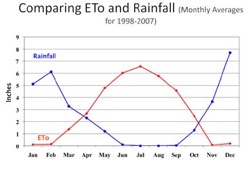
California’s current seasonal flow differential badly needs attenuation. See Graph 2 for an illustration of how evapotranspiration and thus irrigation demand is highest in the months when rainfall is the lowest. Any strategy that can intercept and retain winter flows for use in the dry season will benefit both extremes of the seasonal hydrograph, and potentially improve instream flows when fish need them most.
Roofwater harvesting—capturing, storing and using rainwater that falls on roofs—is ideally suited for this purpose. Roofwater harvesting technology is simple, replicable, and has been applied by numerous cultures for hundreds of years, but California has fallen behind in adoption of this useful strategy. Currently there are examples where roofwater comprises 100% of supply, and countries and US states with worsening drought conditions and increasing total demand on water are supporting roofwater regulation, legislation and implementation. See Appendix 1 for examples from places like Arizona, Hawaii, New Mexico, Texas, the US Virgin Islands and Australia.
Several innovative projects in Northern California (in Humboldt’s Mattole River, SPAWN’s Marin County projects and Sonoma’s Salmon Creek) are demonstrating that roofwater harvesting is an effective means for meeting human needs while reducing demands on dry season stream flows, and warrants expansion into other regions.While proven worldwide, roofwater harvesting still faces significant obstacles to widespread adoption in California.
These obstacles can be loosely divided into two domains: public and private. The public domain is primarily concerned with responsibilities and safeguarding resources—keeping people safe, ensuring adequate flows for aquatic life, providing fair distribution of resources, preventing pollution, and so on. The private domain is primarily concerned with rights and using resources—the right to appropriate,convey and use water as individuals see fit without interference from government, other agencies, or other users. These differing concerns create a breeding ground for unnecessary tension that, almost without exception, requires a clear and obvious win-win situation to resolve.
These solutions do exist. One example is the adoption of roofwater harvesting by municipalities with combined stormwater/sewer systems. Here, roofwater harvesting acts as both a stormwater BMP and a supply augmentation strategy. Flood control, wastewater treatment, agencies supporting endangered salmonids, and water supply companies all share the financial and organizational burden of implementation. This drives cost down for individual agencies while supporting their missions, safeguards the public, and ensures that the private sector receives higher levels of service and supply.
More such solutions are needed in response to declining salmonid populations, climate change and the worsening water crisis. So, NOAA’s Brian Cluer asked OAEC’s WATER Institute to call a brainstorm session Nov. 13th, 2010 to discuss the obstacles to and opportunities for adoption of roofwater harvesting. Present were staff or representatives from NOAA, the state water board, non-governmental organizations, contractors and environmental non-profits.
This document is a result of that meeting, and will explore the obstacles to adoption of roofwater harvesting, and offer solutions to each.
CULTURAL ANALYSIS
Many people are unaware that roofwater harvesting is a legal and viable option here in California. Even with steadily worsening water supply and quality statewide, and escalating interstate feuds over diversions from the Colorado and other rivers, roofwater harvesting still has not become front-page news. Until it does, some means must be found to fill the awareness gap, so policy makers and end users both should be briefed on its potentials.
PROBLEM: Individuals, the business community, policy makers and regulatory enforcement agencies are not all aware that roofwater harvesting exists, or that it is a viable option.
SOLUTIONS: Continue promoting the benefits of roofwater harvesting to individuals, agencies and lawmakers by creating a series of targeted campaigns to drive awareness and prove the efficacy of roofwater harvesting. Have a working group conduct a Sonoma/ Marin-wide education campaign to raise awareness of roofwater harvesting and its benefit (for humans and fish) that includes good maps with clear visuals, demonstration sites accessible to the public, and com- pelling case studies that substantiate value to land and business owners. Simultaneously, convince high pro- file figures to endorse the concept, driving acceptance. Conduct a talk/slideshow tour of coastal communities chosen for their readiness to adopt.
RESOURCES: www.salmoncreekwater.org/cs/ Roofwater_Harvesting.pdf, http://www.oaecwater. org/education/roofwater-harvesting-booklet, www. sscrcd.org/rainwater.php, www.harvestingrainwater. com, www.harvesth2o.com, www.builditsolar.com/ Projects/Water/Water.htm, http://raingardens.spaw- nusa.org/index.html
PROBLEM: The CA plumbing code and the State Public Health Department do not recognize the potential of rainwater as a potable source and therefore do not include roofwater harvesting language in their public resources for indoor use.
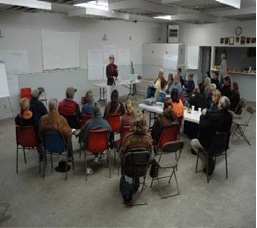
SOLUTIONS: Create a targeted education campaign for state building officials and the Department of Public Health to drive awareness of roofwater harvesting’s ability to provide safe, potable water, while informing them of the risks inherent in the technology so they can adequately safeguard public health. Amend AB 275 (the Rainwater Capture Act of 2011) to support potable use of roofwater.
RESOURCES: (see both reports on domestic use and public water systems) Texas A & M’s guidelines for In Home Use of Rainwater California Department of Public Health Division of Drinking Water and Environmental Management
PROBLEM: Many people are not aware of how much water can be captured from their roof.
SOLUTIONS: Educate people about quantity— most people who do the math are surprised at just how much water they can catch, and awareness drives adoption.
RESOURCES: www.rain-barrel.net/rainwater-calculator.html, SPAWN’s stormwater calculator
REGULATORY ANALYSIS
The questions of water rights and policy highlight the uncomfortable public/private divide, even though California does not currently assert water rights authority over roofwater harvesting. Individuals are justifiably concerned they will lose their pre-existing water rights or be burdened with excess bureaucratic processes and costs if they employ roofwater harvesting. Civil servants, with equal justification, are concerned that public resources will be harmed in the classic “tragedy of the commons” if roofwater harvesting is unregulated. To support responsible public agencies in managing water rights, new and existing legislation needs more explicit roofwater language. For a list of entities that exert power over water in California, see Appendix 2.
PROBLEM: Many people fear losing their riparian rights if they employ roofwater harvest ing to reduce or stop surface diversions.
SOLUTIONS: Provide free legal advice, using grant funding to hire lawyers for people adopting roofwater harvesting and conservation measures. Publicize the benefits of registering riparian rights, and get agencies to fund development of a roofwater harvesting system in exchange for the landowner entering into a “Riparian to Rain” easement or conservation agreement. Include a forbearance agreement where landowners are allowed to store water for more than 30 days for use during summer months, while an NGO monitors stream flows and water usage. This is being successfully implemented in the Mattole watershed.
RESOURCES: Water Storage and Forbearance brochure and Legal Options for Streamflow Protection brochure
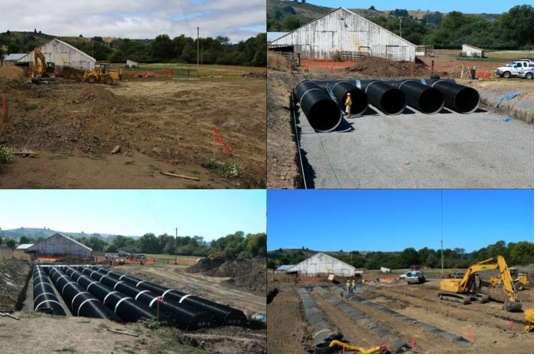
PROBLEM: Some agencies are not exercising their authority in regulating appropriative and riparian rights and streambed alterations. Riparian users have a disproportionate impact on stream health, but their regulations are minimally enforced, thus they have no incentive to invest in tanks.
SOLUTIONS: Support implementation and enforcement of AB 2121 by the State Water Board, and 1602 permit requirements by the California Department of Fish and Game. Determine why agencies lack capacity to enforce these laws, and help them gain such capacity. For existing diversions, make the 1602 permit program retroactive.
RESOURCES: www.dfg.ca.gov/habcon/1600/qa.html, www.swrcb.ca.gov/waterrights/, http://www.ourstreamsflow.org/ab_2121.html
PROBLEM: Water has been overappropriated in many basins.
SOLUTIONS: Create an adequate water budget for each watershed. For agencies with available mitigation funds, encourage them to apply these funds toward development of water right conservation easements. Allow end users who have a roofwater harvesting off- set in place to dedicate their water right using the wa- ter trust or conservation easement model. Other in- centives could include a reduced tax bill in exchange for temporarily relinquishing appropriative rights, following the model of the Williamson Act.
RESOURCES: USGS Water Budgets circular, Legal Options for Streamflow Protection brochure, Trout Unlimited’s Liquid Assets by Steven Malloch, The Trust for Public Land’s Water Acquisition Handbook: A Guide to Acquiring Water for the Environment in California (2003).
PROBLEM: Current and proposed legislation lacks roofwater language.
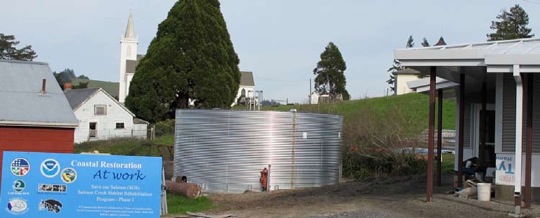
SOLUTIONS: All Senate and Assembly Bills specific to water rights need to include robust, appropriate language about roofwater harvesting. AB 275 (the Rainwater Capture Act of 2011) needs to be amended to support potable use of roofwater. AB 2121 needs to include existing storage and make roofwater harvesting a consideration for diversion structure permits. AB 3030 should promote roofwater harvesting as a demand reduction strategy (eg. Sonoma Valley Groundwater Management Planning Process). AB 1420 (water demand management measures) and AB 1560 (building standards) need rainwater harvesting language as well.
RESOURCES: Lists of statutes, regulations and incentives in USA and abroad: http://www.oaecwater. org/education/roofwater-harvesting-resources, http:// www.harvesth2o.com/statues_regulations.shtml, http://www.harvestingrainwater.com/rainwater- harvesting-inforesources/water-harvesting-tax- credits/
TECHNICAL ANALYSIS
While roofwater harvesting technology is simple and has been implemented worldwide for millennia, California regulators have not yet fully accepted this useful strategy.As a result,end users perceive the permitting and design process as overly complex, while regulators worry that there are insufficient safeguards in place.
PROBLEM: A common belief is that roofwater harvesting will induce growth and sprawl.
SOLUTIONS: Work with land-use planning agencies to develop better growth-regulation tools and encourage the adoption of more serious water conservation measures countywide. Elect a board of supervisors friendly to roofwater harvesting, update city and county general plans to include roofwater harvesting language and hold elected officials account- able for upholding these general plans as passed (such as the Sonoma County General Plan’s Water Resources Element that states “encourage…roof catchment of rainwater…minimizing the need to use potable surface water or groundwater”).
RESOURCES: Sonoma County General Plan WRE Policy WR-4k www.sonoma-county.org/prmd/ gp2020/wre.pdf
PROBLEM: Building codes and zoning requirements can add cost and complexity to the permitting process. State building codes require a building permit, and in some cases an engineering approval as well as a grading permit, for any tank larger than five thousand gallons.
SOLUTIONS: Marin and Sonoma Counties have adopted the state regulations and have the option to modify them to make roofwater harvesting easier. Since tanks smaller than five thousand gallons on flat ground for non-potable use require no permits, end users can install multiple small tanks to eliminate permitting requirements. For larger tanks, simplify the permitting process, or raise the size limit for tanks on flat sites. Waive fees for grading permits if the cut or fill is for roofwater harvesting. Counties could subsidize permit costs. Make zoning variances easier to get for roofwater harvesting tanks by educating and enlisting members of the zoning department. Dedicate a county employee to roofwater harvesting permits who will prioritize large storage systems and fast-track permits that include roofwater harvesting.
RESOURCES: Contact your local building department for permitting and zoning requirements, and review the State of Washington’s attempt to streamline roofwater harvesting permits here: www.harvesth2o. com/statues_regulations.shtml#wa
PROBLEM: Backflow prevention device requirement—Any “auxiliary water supply” requires an annually certified double backflow prevention device if connected to municipal supply.
SOLUTIONS: Make the backflow prevention device part of the municipal system to free the end user from maintenance and certification, and put them in at the meter as standard practice for new construction. Consider using an air gap which can cost less, doesn’t require inspection and is not prone to failure.
RESOURCES: American Backflow Prevention Association www.abpa.org, Backflow prevention Links www.nobackflow.com/backflow.htm, On Tap Magazine’s “Controlling Cross Connections,” Fall ’07 issue www.nesc.wvu.edu/ontap.cfm
PROBLEM: Perception that tanks are ugly, too big and there is nowhere to put them.
SOLUTIONS: Provide information on all the options—tanks that snap together into fences, fit under decks or in basements, can be painted, wrapped in wood, poured out of concrete to look like rocks or have vines growing on them.
RESOURCES: Water Storage: Tanks, Cisterns, Aquifers and Ponds by Art Ludwig www.oasisdesign.net/water/ storage, www.tank-depot.com/tanks/rainwater.aspx
PROBLEM: The design process is costly, time consuming, and suffers from an absence of professionals experienced in roofwater harvesting design.
SOLUTIONS: Offer free site assessments with land- owners to determine appropriate water conservation and harvesting strategies, conduct installer trainings for builders, and provide assistance and resources to the DIY community. Direct people to the available knowledge base and create programs that offer free technical assistance, like SPAWN’s Ten Thousand Rain Gardens program.
RESOURCES: www.raingardens.spawnusa. org/, http://raingardens.spawnusa.org/calculating- stormwater-runoff.html, ARCSA courses for builders www.arcsa.org/content.asp?pl=4&contentid=4
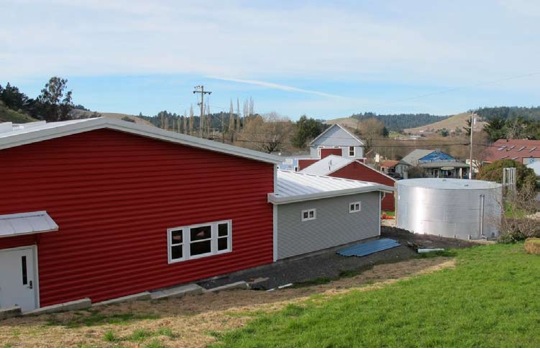
PROBLEM: Quality of roofwater is a concern, during both harvesting and storage over time.
SOLUTIONS: Promote water testing through education and providing free test kits. Build a highly visible public demonstration site and fill station where people can fill drinking water bottles and learn about water testing, first-flush technology and filtration sys- tems. Make NSF 61 certification for tank materials affordable, require manufacturers to provide Materials Safety Data Sheets for roofing and tank materials, and help people decode this information. Generate a fact sheet demonstrating water quality differences between roofwater and untreated groundwater. Educate users about adequate pretreatment, filtration and disinfection methods. Educate people concerned with “stagnant” water and mosquito breeding about aeration, ozona- tors, and vector control.
RESOURCES: Oasis Design rainwater harvesting information on water testing and filtration www. oasisdesign.net/water/rainharvesting/index.htm, roofing materials and water quality http://www. thecenterforrainwaterharvesting.org/2_roof_gutters2. htm, Biological Sand Water Filters and Roof Water Harvesting www.enlight-inc.com/blog/?p=14, SPAWN’s demonstration sites http://raingardens. spawnusa.org/public-demonstration-projects.html, Marin/Sonoma Mosquito and Vector Control District www.msmosquito.com
SCIENTIFIC ANALYSIS
General hydrologic illiteracy is pandemic—many end users cannot name their watershed or explain where their water comes from. This is especially pernicious given California’s radically modified water systems. With ignorance the norm, building a case for adoption of roofwater harvesting will require solid science as a foundation, and clear messaging broadcast as widely as possible.
PROBLEM: Lack of science to prove need for offsets—Many people believe that wells do not impact creek flows, and the burden of proving the impact of extraction rests on under-supported scientific and regulatory bodies. Solid, actionable water analysis is lacking countywide and existing models are insufficient, while the Army Corps of Engineers’ statewide water balance process is extremely slow and ignores sedimentation and unreported diversions.
SOLUTIONS: Secure funding for studies like the Estuary Study on lower Salmon Creek that prove the impact of subsurface extraction on dry season flows. Conduct studies that link ridge-top wells to decreased dry season flows and track the impact of trucking com- pany’s inter-basin transfers on source watersheds. Shift scientific burden to extractors, requiring them to prove their water extraction is not affecting instream flows.
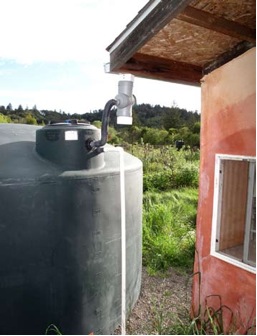
RESOURCES: USGS Ground Water and Surface Water circular http://pubs.usgs.gov/circ/circ1139/, Salmon Creek Estuary Study
PROBLEM: Belief that tanks steal water from fish.
SOLUTIONS: Gather existing, and conduct new research to demonstrate the invalidity of this concept, and use it to create an ad campaign with public service announcements and fact sheets to help people understand how capturing water for use during the dry season helps fish.
RESOURCES: Prince George’s County Department of Environmental Resources Low-Impact Development Hydrologic Analysis www.epa.gov/owow/nps/ lid/lid_hydr.pdf
PROBLEM: California Fish and Game Salmonid Stream Habitat Restoration manual lacks protocols addressing water quantity and stream flow restoration.
SOLUTIONS: Fish and Game requires adherence to the protocols in the manual before providing fund- ing for implementation of a stream restoration project, making this manual a key point for introduction of language mandating improved instream flows. Find funding to write and incorporate a new chapter on instream flow restoration strategies.
RESOURCES: To see current language, go to www.dfg.ca.gov/fish/REsources/HabitatManual.asp
ECONOMIC ANALYSIS
Water is bulky, heavy, and requires that expensive tanks be purchased up front to retain it, and no technology currently exists to mitigate these factors. With all current water-pricing structures grossly undervaluing water statewide, taxpayers and the environment are subsidizing the externalized costs of “free” groundwater and “cheap” surface diversions. These externalities include reduced availability and degraded quality of water for both humans and endangered salmonids. With one-time purchase costs hovering around $1-2/gallon of installed storage, roofwater harvesting cannot compete on a purely economic basis with unregulated groundwater or surface flows, even factoring in the energy costs of pumping water. Therefore, any proposed solution must include a means to reduce the initial cost of a system.
PROBLEM: People believe they need a year-round water replacement, which will be too expensive and bulky.
SOLUTION: Educate people that in Northern California, we only need to create storage for a 6-8 month dry-season supply to improve water flows for fish.
RESOURCE: www.cohopartnership.org, www.spawnusa.org, www.sanctuaryforest.org
PROBLEM: General Cost—Large systems are expensive even if you have a flat site and no other problems, and people are concerned that the installation of a roofwater harvesting system will trigger a reassessment of property value and increase property taxes. Since roofwater cannot be used to permit a new build, but can only serve as an auxiliary water supply to a permitted well or diversion, adopters have significantly greater up-front costs than non-users.
SOLUTIONS: Help people take advantage of existing rebate and tax incentive programs and work to get more programs adopted (City of Santa Rosa offers $.25/gal for storage). Leveraging the energy benefits of roofwater harvesting to get these programs adopted county and statewide will help reduce up-front costs for users (like Sonoma County Energy Independence Program). Secure matching funds to further offset costs up to 100%. Lobby board of supervisors to waive tax reassessment of properties that install roofwater harvesting (see Bodega Pilot program). Offer fee waivers from planning/permitting departments. Making roofwater harvesting installation mandatory for new-build permits would ensure compliance (like Queensland state, AU).
RESOURCES: Second Nature by Treepeople http://www.treepeople.org/second-nature-adapting-las- landscape-sustainable-living, City of SR Incentive Pro- gram http://ci.santa-rosa.ca.us/departments/utilities/ conserve/Pages/RainwaterHarvesting.aspx, Sonoma County Energy Independence Program http:// www.sonomacountyenergy.org/water-conservation. php#waterconservation,Washington State stormwater offset program http://www.kitsapgov.com/sswm/pdf/ ordinance 314-2004.pdf, Salmon Creek Bodega Pilot Program www.salmoncreekwater.org/bodega-pilot- program.html
PROBLEM: Many California municipalities are not developing roofwater harvesting as a storm water bmP due to perceived excess costs.
SOLUTIONS: Educate agencies about the cost parity between installation of roofwater harvesting and stormwater mitigation, highlighting the double benefit of roofwater harvesting as supply augmentation and runoff reduction. Educate the public about the emergence of “stormwater utility fees”, the com- parative cost of roofwater harvesting, and the advantag- es of installing a system. Approach municipalities that discharge excess stormwater, and advocate for roofwater harvesting installation.
RESOURCE: http://stormwaterfinance.urbancen- ter.iupui.edu/SUother.htm
PROBLEM: Commercial—Cost may be prohibitive at the acre-foot scale agriculture needs. Since 60-80% of California’s developed water supply goes to agriculture, a win here would have tremendous impact, but there may be a volumetric boundary beyond which the cost of tanks is so extreme that roofwater is not a practical solution. In these cases education is key, because numerous other options exist that will improve dry season flows. As an example, a possible solution for vineyards is to use their manufactured hardscape and subsurface drains to catch runoff in ponds that supply their irrigation needs.
SOLUTIONS: Evaluate the cost effectiveness of roofwater harvesting at varying scales and find the threshold above which it is no longer cost effective. Identify users with high impacts but relatively low volume use, and educate them about roofwater harvesting’s potential— dairies are a potential target here. Finding large donors to finance large-scale systems could begin with includIng roofwater harvesting as a fundable project for the State Water Resources Control Board revolving fund, and making non-governmental organizations eligible.
RESOURCES: Gold Ridge RCD Save Our Salmon project http://www.goldridgercd.org/project/SOS. html, Rainfall Capture and Storage for Marin Agricul- ture http://groups.ucanr.org/GIM/Files/81887.pdf
PROBLEM: Commercial scale users are unaware of the benefits of roofwater harvesting.
SOLUTIONS: Educate business owners of the economic benefits of roofwater harvesting. Promote the marketing potential of roofwater harvesting for a lower carbon footprint, energy savings and better flows for fish—consider examples like Salmon Safe in Oregon. For organic operations, highlight how roof- water harvesting helps meet water quality standards. Agricultural operations facing frost protection limits and other legislation are potential early adopters and word-of-mouth advocates.
RESOURCES: www.salmonsafe.org/getcertified, www.cohopartnership.org
PROBLEM: Municipal—lack of compelling reasons for end users to change. Water is too cheap and enforcement too lax, which makes it nearly impossible to compel users to con- serve. Many users don’t know where their water comes from or what the true cost is, but are attached to their pre-existing rights, making adjustments to existing water delivery systems or pricing difficult.
SOLUTIONS: Limiting the use of municipal water for landscaping like Tucson (50% must come from harvested rainwater for commercial buildings) is a good start. In areas where tiered pricing fails to change user’s behavior, making the 2nd and 3rd tiers more expensive will help. Imposing an outright gallon limit on usage, and turning the water off when the limit is exceeded, would guarantee compliance. Increased enforcement for diversion violations would reduce over-extraction as well as providing revenue for State programs.
RESOURCES: Tucson’s Code is available at http://www.tucsonaz.gov/ocsd/sustainability/water/ rainwaterharvesting.php, The California Urban Water Conservation Council resource, on pricing structures www.cuwcc.org/resource-center/resource-center. aspx, AWWA’ Tiered Water Rates Resources http://www.awwa.org/Resources/content. cfm?ItemNumber=56369
PROBLEM: Municipal—suppliers lose revenue when end users adopt roofwater harvesting. When municipalities make money on supplying water, they are understandably reluctant to cut off their own revenue stream, much less to offer incentives to adopters.
SOLUTIONS: Stormwater is a better starting place for a win with municipalities than supply, since the value of roofwater harvesting is well understood as a BMP for stormwater management. Educating municipalities about the multiple benefits of roofwater harvesting, and the potential for multi-agency funding, will help build support. On the supply/revenue side, municipal suppliers need to be able to keep their revenue stream while selling less water, and decouple the cost of raw water from the cost of the infrastructure that captures, delivers and treats it. Implement a “decentralized production, centralized management and oversight” business model, where the municipality would be responsible for quality rather than quantity, and charge for management and infrastructure instead of raw water. This model will have a broad geographic influence, offer green jobs potential, and help communities build resilience by diversifying their water supply and storage. Bodega Bay, Stinson Beach, and some other coastal communities are under notice from the water board to shift to an appropriative right,which limits their time of diversion, and are good candidates for pilot programs.
RESOURCES: Refer to Conservation Strategy #7: Water Rates for Rural Coastal California Communities by Virginia Porter www.salmoncreekwater.org/cs/Wa- ter_Rate Conservation.pdf, Aakash Ganga system in India www.si-usa.org/projects/rainwater-harvesting
RECOMMENDATIONS
Based on our findings during the meeting, we recommend the following actions:
- Support the adoption of roofwater harvesting by those users whose water demand negatively impacts dry-season stream flows in salmonid-bearing watersheds, whether by direct diversion of surface water or extraction from shallow gallery wells hydrologically connected to the stream.These users should be the first to install a six to eight-month supply derived from roofwater harvesting to be used only during the dry season:
- Small coastal communities and municipal systems, whether privately-owned or as a part of the municipality’s decentralized supply.
- High-density rural residential private properties with large cumulative impact.
- High-density or high-volume agricultural riparian users, especially those with pre-existing infrastructure that supports cost-effective adoption.
- Design and conduct studies that:
- Accurately assess and demonstrate the connections between groundwater, underflow, surface waters and instream flows.
- Prove roofwater harvesting systems benefit instream flow restoration.
- Prove efficacy and support adoption of roofwater harvesting for both indoor and outdoor use.
- Re-write existing water rights law to support land-owners in reducing impact on stream flows while protecting their water security.
- Review and amend existing, or implement new public policy that includes roofwater harvesting language in:
- General plans, building codes, zoning and health department regulations.
- California Department of Fish and Game Stream Restoration Manual.
- Federal and State Coho Recovery plans.
- Groundwater and stormwater management plans.
- Develop programs to fund statewide adoption of roofwater harvesting, including direct incentives, tax breaks or grants, from a diverse portfolio of sources including federal and state governments, non-governmental organizations, non-profits, and private philanthropy.
- Create a successful roofwater harvesting industry by supporting product development, training installers, and creating demand through incentives and policy.






